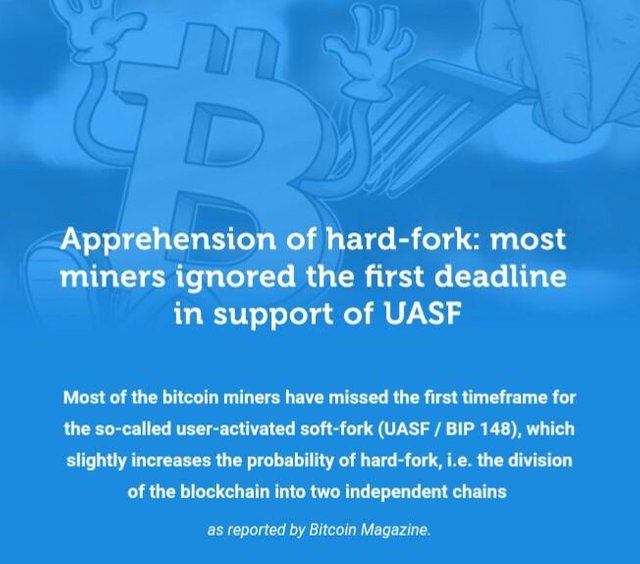APPREHENSION OF HARD-FORK: MOST MINERS IGNORED THE FIRST DEADLINE IN SUPPORT OF UASF

The next two weeks are likely to be the culmination of the lengthy discussions about the bitcoin road map. One of the proposals – UASF (BIP 148) may give rise to the activation of the Segregated Witness (SegWit) protocol at 00:00 UTC on August 1. One of its features is that all user nodes that are currently signaling support for UASF, will begin to reject blocks with the indication of time that do not contain the same support for the specified time.
BIP 148 and SegWit are backward compatible protocol upgrades. This means that nodes that have not upgraded will still accept blocks that either signal in support of SegWit, or are already using this protocol. Thus, if before August 1 most of the miners’ capacities will accept SegWit in at least one of these ways, all of the current nodes in the bitcoin network will continue following the same chain.
At the same time, if activation of SegWit through BIP 148 is carried out only by a small part of the miners, the bitcoin blockchain, as well as the cryptocurrency itself, will undergo division into two separate chains. As a result, at least two bitcoins will be formed (another series of alternative chains, such as Bitcoin ABC, another child of the Chinese company Bitmain, may appear).
In case of a chain separation, the division between the nodes will continue until most of the processing power of the network connects to the BIP 148 chains, or until the BIP 148 chain is permanently abandoned by all users and miners.
How can a bitcoin network avoid separation?
To prevent such a scenario, the miners have three main options.
The first one is fixing the SegWit protocol until August 1 through the activation mechanism proposed by the Bitcoin Core development team and already implemented in many nodes. To do this, however, an alarm is required on the part of the owners of 95% of the network hashrate for a 2-week period of complexity. Such a period of complexity consists of 2016 consecutive blocks, but for fixation it is necessary to signal on the part of at least 1916 blocks. In other words, if more than 100 blocks (at least 101) do not signal SegWit support during one period of complexity before August 1, deadline in support of UASF (BIP 148) is considered to be missed.
The last period of complexity, which will be completed before August 1, was launched on Friday, July 14. However, as the data of Coin.dance show, 44% of all the blocks found signal about readiness to SegWit for the first two days. At the same time, a significant majority of hashrate miners make it clear that instead it they intend to activate SegWit via BIP 91, a proposal designed to ensure compatibility of SegWit2x (another solution involving activation of SegWit) and 83% of the bitcoins who have already supported the SegWit version.
The next deadline for the activation of BIP 148 is July 29. This is the last day when BIP 91 can be activated to be compatible with BIP 148, and this will require 80% of the support for the miners within 2 days and 8 hours. In view of the allotted time, the last term, when the miners should start signaling their support, is July 26.
If this time is missed, the miners will have another opportunity to avoid splitting the network, and they will need to support SegWit directly through BIP 148 by 00:00 UTC on August 1. As an alternative scenario, the majority of the hashrate may switch to the BIP 148 chain even after August 1, but this is likely to result in significant stress in the bitcoin network and the likely loss of user funds unaware of possible risks.
In order to avoid undesirable consequences, it is necessary to take into account that, starting from the last days of July and early August, it is best to avoid any transactions on the network. Also, you should not store your bitcoins on stock exchanges that do not allow you to create local copies of private keys.
Source: Team CRYP TRADE CAPITAL HOLDING